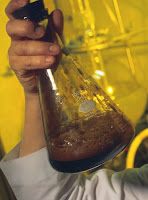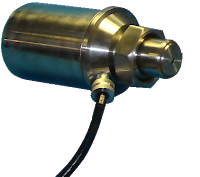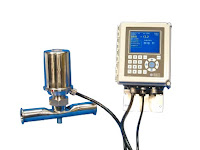| Recovery Boiler (courtesy of Wikipedia) |
“Black liquor” is a term used for the waste products that result from the pulping process. The black liquor recovery boiler (BLRB) allows for the chemicals in the waste products to be reclaimed via combustion. These reclaimed chemicals are then utilized to both meet steam demands in the process and to generate electricity.
Modern day BLRBs are designed similarly to industrial boilers, typically as two drum designs, for operating pressure under 900 psi, or single drum designs, for operating pressure over 900 psi. The combustion gases utilized by the boilers can be sticky, so the BLRB furnaces are taller than their utility or industrial watertube counterparts. The amount of pulp producible by a particular mill directly correlates to the size of the BLRB. Small BLRBs process about 750,000 pounds of dry solids per day, and larger BLRBs process about six million pounds of dry solids per day. Precise attention and vigilant maintenance are required in order to maximize investment return for each particular boiler.
In order to ensure stabilization of combustion, BLRBs are equipped with auxiliary burners which raise boiler temperature for the combustion process. The firing of the black liquor will eventually become self-sufficient. Combusting the black liquor allows for sulfur compounds used in the pulping process to be reduced to sulfide while inorganic chemicals essential to the process are melted down for reuse. The furnace vaporizes the black liquor as the liquor is sprayed into the furnace. Extra water is vaporized, and some of the combustion takes place as the black liquor falls to the furnace’s floor. The resulting molten smelt flows through spouts, which are operantly cooled via water, to a smelt dissolving tank.
A particular risk of the BLRB process stems from the relationship between molten smelt and water. The pool of molten smelt that accumulates as a result of the reclamation process needs to be kept separate from water, because water and molten material mixing at high temperatures can result in a smelt-water explosion. These explosions can occur when black liquor water content is greater than 42% of the mixture. Additionally, there are numerous ways water can enter the process – as condensation from the soot blower, a faulty steam coil heater, wash hoses – so controller vigilance is absolutely key to explosion prevention.
The Black Liquor Recovery Board Advisory Committee has recently introduced an emergency shutdown procedure, where an emergency evacuation alarm signals as soon as suspected water enters the BLRB furnace. The operator, with corresponding training, shuts down all fuel flow and minimizes combustion until all but a minimal amount of water is drained rom the BLRB. Annual inspections of BLRBs mandate the testing of all pressure parts and safety systems, because utmost care must be assured in preventing risk of system damage or operator harm when dealing with BLRB processes.
Modern day BLRBs are designed similarly to industrial boilers, typically as two drum designs, for operating pressure under 900 psi, or single drum designs, for operating pressure over 900 psi. The combustion gases utilized by the boilers can be sticky, so the BLRB furnaces are taller than their utility or industrial watertube counterparts. The amount of pulp producible by a particular mill directly correlates to the size of the BLRB. Small BLRBs process about 750,000 pounds of dry solids per day, and larger BLRBs process about six million pounds of dry solids per day. Precise attention and vigilant maintenance are required in order to maximize investment return for each particular boiler.
 |
| Black Liquor |
A particular risk of the BLRB process stems from the relationship between molten smelt and water. The pool of molten smelt that accumulates as a result of the reclamation process needs to be kept separate from water, because water and molten material mixing at high temperatures can result in a smelt-water explosion. These explosions can occur when black liquor water content is greater than 42% of the mixture. Additionally, there are numerous ways water can enter the process – as condensation from the soot blower, a faulty steam coil heater, wash hoses – so controller vigilance is absolutely key to explosion prevention.
The Black Liquor Recovery Board Advisory Committee has recently introduced an emergency shutdown procedure, where an emergency evacuation alarm signals as soon as suspected water enters the BLRB furnace. The operator, with corresponding training, shuts down all fuel flow and minimizes combustion until all but a minimal amount of water is drained rom the BLRB. Annual inspections of BLRBs mandate the testing of all pressure parts and safety systems, because utmost care must be assured in preventing risk of system damage or operator harm when dealing with BLRB processes.

